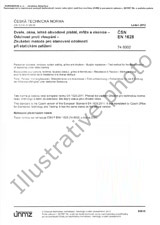We need your consent to use the individual data so that you can see information about your interests, among other things. Click "OK" to give your consent.
ČSN EN ISO 19581 (404018)
Measurement of radioactivity - Gamma emitting radionuclides - Rapid screening method using scintillation detector gamma-ray spectrometry
Translate name
STANDARD published on 1.8.2020
The information about the standard:
Designation standards: ČSN EN ISO 19581
Classification mark: 404018
Catalog number: 510354
Publication date standards: 1.8.2020
SKU: NS-1000851
The number of pages: 32
Approximate weight : 96 g (0.21 lbs)
Country: Czech technical standard
Category: Technical standards ČSN
The category - similar standards:
Annotation of standard text ČSN EN ISO 19581 (404018):
This document specifies a screening test method to quantify rapidly the activity concentration of gamma-emitting radionuclides, such as 131I, 132Te, 134Cs and 137Cs, in solid or liquid test samples using gamma-ray spectrometry with lower resolution scintillation detectors as compared with the HPGe detectors.
This test method can be used for the measurement of any potentially contaminated environmental matrices (including soil), food and feed samples as well as industrial materials or products that have been properly conditioned. Sample preparation techniques used in the screening method are not specified in this document, since special sample preparation techniques other than simple machining (cutting, grinding, etc.) should not be required. Although the sampling procedure is of utmost importance in the case of the measurement of radioactivity in samples, it is out of scope of this document; other international standards for sampling procedures that can be used in combination with this document are available.
The test method applies to the measurement of gamma-emitting radionuclides such as 131I, 134Cs and 137Cs. Using sample sizes of 0,5 l to 1,0 l in a Marinelli beaker and a counting time of 5 min to 20 min, decision threshold of 10 Bq˙kg-1 can be achievable using a commercially available scintillation spectrometer [e.g. thallium activated sodium iodine (NaI(Tl)) spectrometer 2" × 2" detector size, 7 % resolution (FWHM) at 662 keV, 30 mm lead shield thickness].
This test method also can be performed in a "makeshift" laboratory or even outside a testing laboratory on samples directly measured in the field where they were collected.
During a nuclear or radiological emergency, this test method enables a rapid measurement of the sample activity concentration of potentially contaminated samples to check against operational intervention levels (OILs) set up by decision makers that would trigger a predetermined emergency response to reduce existing radiation risks.
Due to the uncertainty associated with the results obtained with this test method, test samples requiring more accurate test results can be measured using high-purity germanium (HPGe) detectors gamma-ray spectrometry in a testing laboratory, following appropriate preparation of the test samples.
This document does not contain criteria to establish the activity concentration of OILs



 Cookies
Cookies
